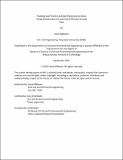Tracking Dust Plumes and Identifying Source Areas Using Spatiotemporal Clustering of Remote Sensing Data
Author(s)
Alnasser, Faisal
DownloadThesis PDF (26.74Mb)
Advisor
Entekhabi, Dara
Terms of use
Metadata
Show full item recordAbstract
Traditionally, studies on dust relied on polar-orbiting satellites whose limited tempo-ral coverage does not offer a detailed picture of how dust plumes evolve and change over time. To address this, we develop a method to identify and track individual dust plumes via hourly images from the Meteosat Second Generation Spinning Enhanced Visible and Infrared Imager (SEVIRI) instrument on the Eumetsat geostationary or-bit satellites. Our framework uses the SEVIRI Dust RGB false color composite to highlight airborne dust in images. We then use the DBSCAN machine learning algo-rithm to cluster pixels into plumes based on their spatial and temporal connectivity. Through careful analysis and processing, we are able to analyze properties such as the storm’s source area, distance traveled, and affected areas. Through our framework, we gain insights into dust storm sources, emission factors such as soil moisture, wind speed, and vegetation, and their seasonal effects, which are key for understanding dust impacts on air quality, health, and the environment. To illustrate the effective-ness of our methodology, we conduct comprehensive case studies on several prominent dust-emitting regions: the Bodélé Depression, Southern Iraq, the Syrian Desert, and the Sistan basin. These case studies shed light on the complex effects of drought and the interplay between soil moisture and vegetation as well as their effects on plume properties. Providing an understanding of the different variables contributing to dust storm dynamics.
Date issued
2023-09Department
Massachusetts Institute of Technology. Department of Civil and Environmental EngineeringPublisher
Massachusetts Institute of Technology